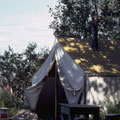Cree Communities
Quicklinks
- First Nations Environment
- Cree Communities
- Changing Communities
Our world is a big place, and it is populated by many different people. In fact, right now there are over six and a half billion people on Earth. Some parts of the world are more heavily populated than others. Canada, for instance, is the second largest country in the world in terms of land but only has a population of 32 million. Much of Canada’s vast land remains uninhabited.

The world is divided into over 190 officially recognized countries. Many of these are called monocultural countries. This means that most—and, in some cases, all—of the people living within that country are very similar to one another. They share similar beliefs, traditions, language, and culture. Other countries are considered multicultural countries. The people living in these countries share different beliefs, traditions, and cultural backgrounds. One group of people may have learned one first language, while members of another group may have learned a completely different one.
Canada is a multicultural country. There are a lot of people from different cultures living in Canada. Some of those people are the descendants of what sometimes are called the First People of Canada. The First People of Canada are those who lived here before anyone else; they are the first people to have lived in this part of the world. The descendants of the First People of Canada are themselves a multicultural group; each community represents a unique set of traditions, customs, cultural practices, and, in some cases, languages. Today, the descendants of the First People are commonly known as Aboriginal People, Native People, First Nations People, and the Inuit People. Which of these terms is used depends on the part of Canada in which these people lived.

The First People who lived in the Boreal Forest—and their descendants—are generally referred to as Aboriginal People. There are many different distinct Aboriginal cultures in Canada, and they can be found in places across the country.
The Aboriginal people of the Boreal Forest form a diverse multicultural group. The single largest Aboriginal community in Canada, and also in the Boreal Forest as a whole, is made up of the Cree people. However, the Cree people are not all the same. This also applies to most other Aboriginal and non-Aboriginal communities in Canada. This is because people of the same ancestry who end up living in different parts of the world, whether in the same country or not, are often influenced by the place in which they live. Over time, they may change. This change can include the development of new customs, beliefs, and knowledge. It may even include the formation of new dialects and languages. This is the reason so many people of the same ancestry also tend to identify themselves not only in terms of that ancestry, but also in terms of the region in which they live. For example, a Cree person from a particular part of Ontario might identify himself as part of the Moose Cree community while a Cree person from a particular part of Alberta might identify herself as part of the River Cree community.

There are two main Aboriginal language groups spoken in the Boreal Forest region: Athapascan and Algonkian. These language groups can be further subdivided into a number of different regional Aboriginal languages or dialects. Athapascan speakers, in part, are also known as Dene, and this group includes a number of different Aboriginal Peoples such as the Dogrib of the Northwest Territories; the Dunne-za (Beaver) People and the Dene-tha (Slave or Slavey) People, both of northern Alberta; and the Chipewyan, whose traditional lands covered an area of northern Saskatchewan and northeast Alberta.
Dene communities are among the oldest in the northwest. The speakers of the various Cree dialects, like the Plains Cree dialect (used primarily in Alberta, British Columbia, the Northwest Territories, and Saskatchewan), the Woodland Cree dialect (used primarily in Alberta, Manitoba, and Saskatchewan), the Swampy Cree dialect (used primarily in Manitoba, Ontario, and Saskatchewan), the Moose Cree dialect (used primarily in Ontario), and the Northern and Southern East Cree dialects (used primarily in Québec) are but a few more widely used and notable forms of Cree, which is itself an Algonkian language.






